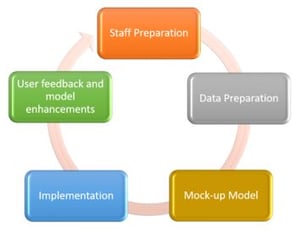The ASC 606 revenue recognition rules took effect for most public companies in December 2017. This Accounting Standards Update explains how and when your organization would recognize revenue from contracts with your customers. The guideline helps improve the comparability of revenue recognition practices, provide more useful information to financial statement users, and simplify the preparation of financial statements, for example. While many companies have gone through the trouble to restate actuals to follow the new ASC 606 standards, some are not yet ready to forecast and plan revenue on the same basis. They still need to update their budgeting and forecasting processes to align with the new standards. Here are FIVE STEPS to follow to update your planning processes and model to conform to the ASC 606 standards.
Step 1: Staff Preparation
The first step is staff preparation. You will need to understand the ASC 606 standards and the new revenue recognition method from end-to-end. Most companies hire specialists to help them with this step, however several resources are available online that cover the concepts and details of the new regulation
Step 2: Data Preparation
The second step is about data preparation. Historical data, in most cases, needs to be restated to reflect the new standards. For planning data, you may need new forecast drivers so you should also think about the data flow of the new drivers. Do you have the data in the existing database or do you need to source the data from a new system? Some companies would like to retain the legacy data, so a decision needs to be made regarding how this data is stored and retrieved.
Step 3: Build a Prototype Model
In the third step you will build a prototype, or mock-up, of the new forecast model using your planning tool which may be Microsoft Excel, or an enterprise planning solution like IBM Planning Analytics or Adaptive Insights. The mock-up serves two purposes: to verify the new calculations and to validate the new model after the implementation. You do not need to create a mock-up for the whole forecast model. You only need the mock-up to have new calculations and the data impacted by these calculations. It is critical that you capture all new changes in the mock-up to prevent rework when the new forecast model is implemented in production.
Step 4: Implement the Changes
The fourth step is for developers to update the current forecast model in your planning tool. If developers are already familiar with your model, this step will go much faster. Your role is to test the new model and provide feedback to developers. After the model is built and tested in the development environment, developers will iteratively implement the changes in production. It would be a good idea to provide training to end users before the model is released in production.
Step 5: Monitor for Continuous Improvement
The last step is an ongoing process to collect feedback from users and prioritize enhancements. No model is perfect and business constantly evolves, therefore periodic model updates will help reflect business changes and improve the accuracy of the forecast.
In summary, the ASC 606 standards affects not only the revenue recognition process for actuals but also the plan and forecast models. The preparation of both data and human resources is key to a successful ASC 606 implementation. A mock-up ensures that the new model will be robust and accurate. Experienced developers will help save time and money: if you do not have in-house development skills, make sure you engage with external consultants (such as QueBIT!) as early as Step 2. Finally, even after Go-Live the model can be improved. The list of improvements needs to be prioritized and then deployed accordingly. Following this five-step iterative approach will greatly mitigate risk when implementing ASC 606 revenue recognition standards within the financial processes of your organization.